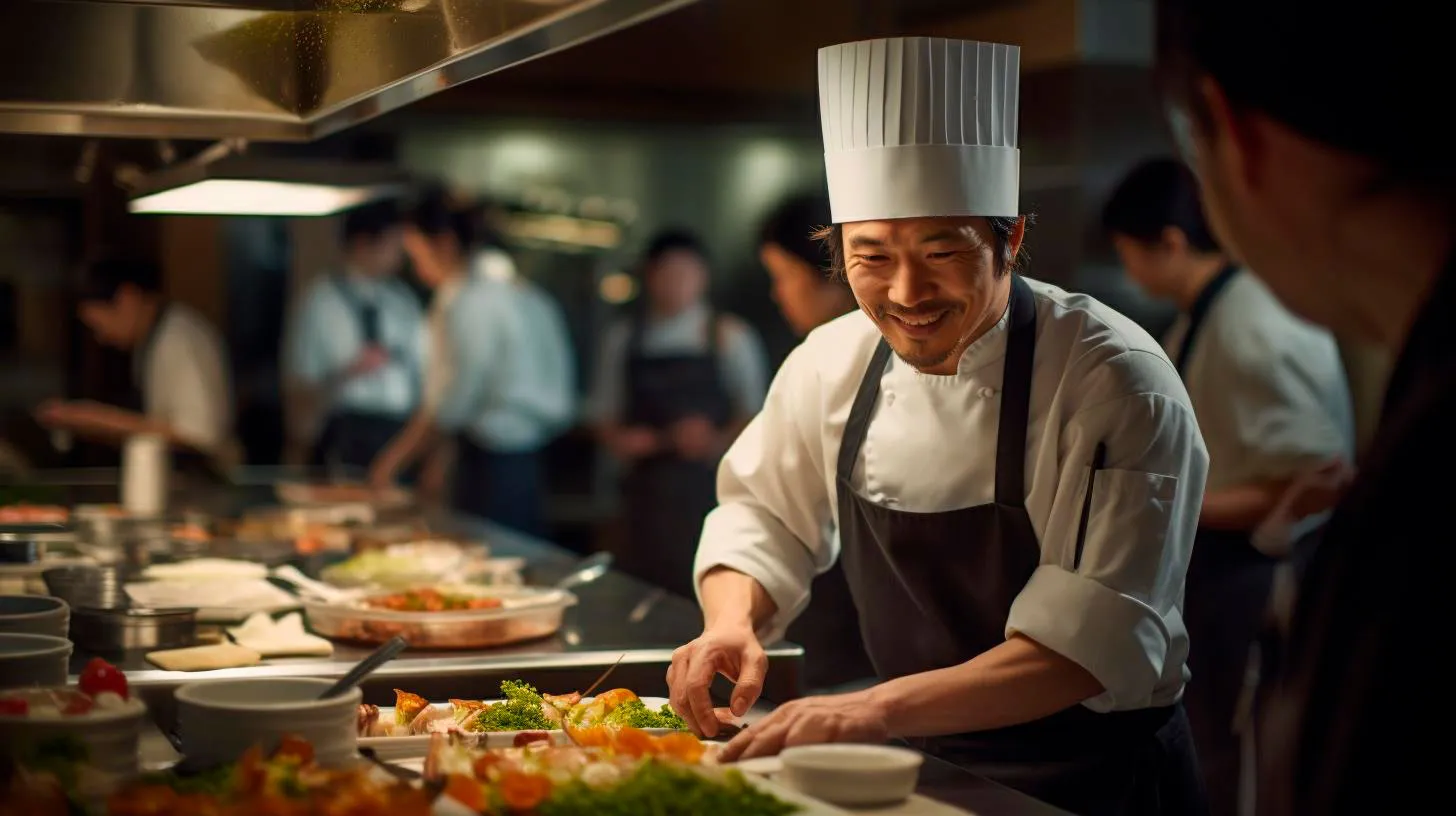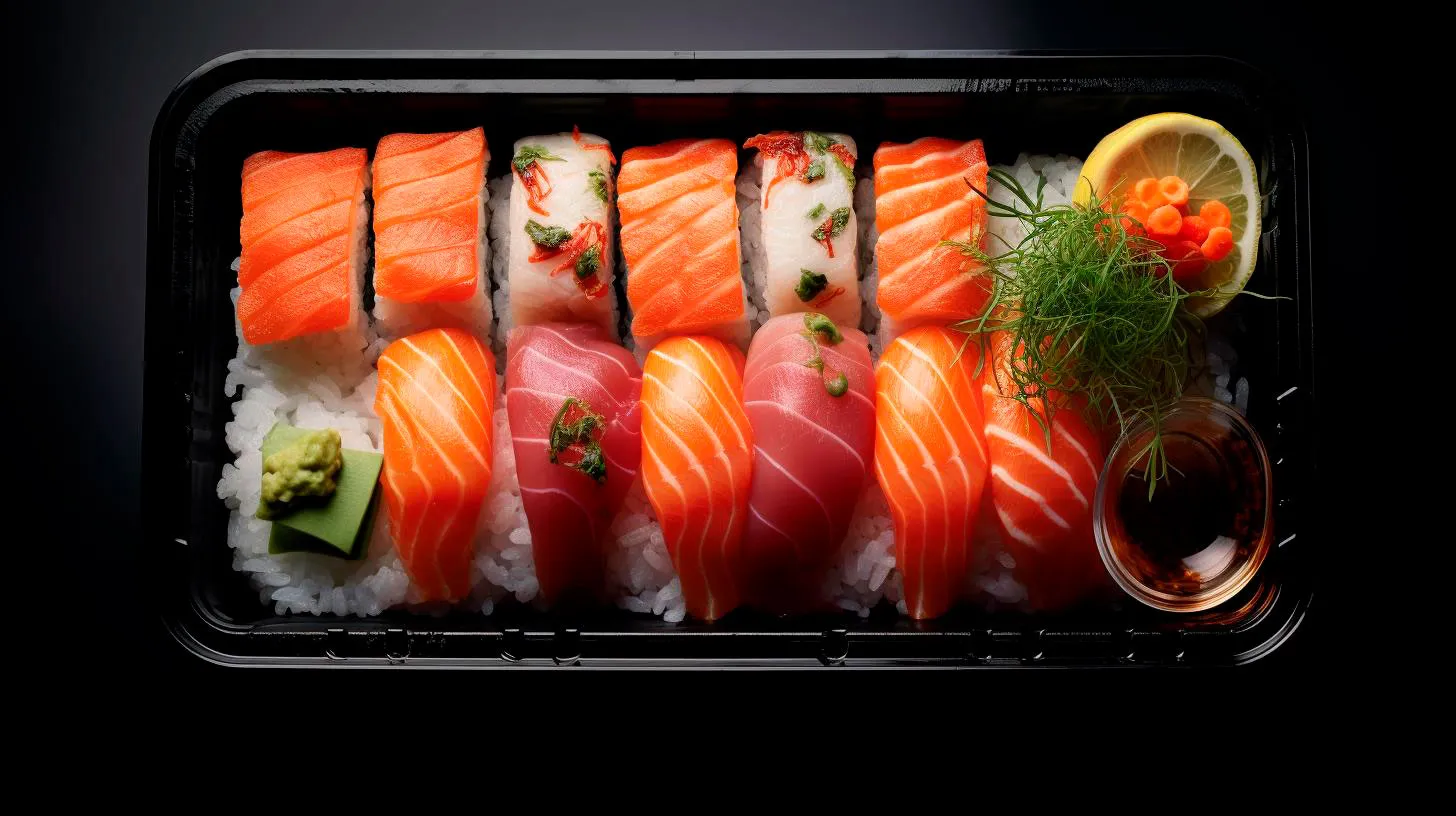Pushing Boundaries: Innovative Sushi Creations Ignite Taste Buds
These avant-garde dishes not only surprise and delight diners but also showcase the artistic and inventive nature of sushi. In this article, we will explore some of the most cutting-edge sushi creations that are revolutionizing the way we experience this beloved cuisine.
The Rise of Fusion Sushi
Fusion cuisine, the marriage of different culinary traditions, has been gaining popularity across the globe. Sushi is no exception, as chefs experiment with combining Japanese ingredients and techniques with elements from various other cuisines, resulting in flavors that transcend traditional boundaries. Some key examples of fusion sushi include:
- Sushi Burritos: These oversized sushi rolls wrap traditional ingredients like raw fish, rice, and vegetables in a tortilla, providing a handheld alternative to classic sushi rolls. Their larger size allows for more diverse flavor combinations and fillings, such as Korean barbecue or Mexican-inspired ingredients.
- Sushi Tacos: Combining the best of Japanese and Mexican cuisine, sushi tacos offer a unique twist on traditional sushi. These small, crunchy taco shells are filled with sushi rice, fresh fish, avocado, and various sauces, creating a fusion of textures and flavors that tantalize the taste buds.
- Sushi Pizza: Sushi and pizza come together in this extraordinary creation. A crispy rice crust serves as the base, topped with fresh sashimi, avocado, and Japanese mayo, resulting in a harmonious blend of textures and flavors. Sushi pizza is a visual masterpiece that is equally delightful to eat.
Shining a Light on Molecular Gastronomy
Molecular gastronomy, a scientific approach to cooking, has had a significant impact on the sushi scene. Utilizing cutting-edge techniques and equipment, chefs have been able to deconstruct traditional sushi elements and reconstruct them in innovative ways.
Key examples of sushi creations rooted in molecular gastronomy include:
- Sphere Sushi: By using a technique called “spherification,” sushi can be transformed into bite-sized spheres bursting with flavor. Each sphere contains a harmonious combination of sushi rice, fish, and other ingredients, encased in a thin gel-like membrane. These visually stunning bite-sized creations deliver an explosion of flavors in a single bite.
- Smoky Sushi: With the help of smoke guns and other smoking techniques, sushi chefs have begun infusing their creations with enticing smoky aromas. The smoke enhances the overall taste experience by adding depth and complexity to the flavors, creating a tantalizing and sensory-rich sushi encounter.
Embracing Sustainable Sushi
As global awareness of environmental issues rises, so does the demand for sustainable food choices. Sushi chefs have taken notice, going beyond traditional offerings to embrace environmentally friendly practices and ingredients.
Some sustainable sushi practices to watch out for include:
- Farm-Raised Sustainable Seafood: Sushi restaurants are now increasingly sourcing their fish from sustainable aquaculture farms. These farms promote environmentally responsible fishing practices, ensuring the longevity of fish populations while minimizing harm to marine ecosystems.
- Plant-Based Alternatives: To cater to vegetarian and vegan diners, sushi chefs are exploring plant-based alternatives to fish. Utilizing ingredients such as tofu, mushrooms, and root vegetables, they create imaginative rolls that mimic the flavors and textures of traditional sushi, while offering a more sustainable option.
- Recycling and Waste Reduction: Sustainable sushi restaurants proactively address the issue of plastic waste by using biodegradable or reusable packaging. Furthermore, some establishments have implemented recycling programs and invest in energy-efficient technologies to minimize their environmental impact.
Key Takeaways
The world of sushi is continuously evolving, and these innovative creations are just the tip of the iceberg. Embracing fusion cuisine, molecular gastronomy, and sustainable practices, sushi chefs are pushing boundaries and redefining what it means to enjoy this traditional Japanese dish. The key takeaways from this journey into the realm of innovative sushi creations are:
- Experience the fusion of flavors with sushi burritos, sushi tacos, and sushi pizzas.
- Indulge in the visual and flavorful masterpieces of molecular gastronomy, such as sphere sushi and smoky sushi.
- Opt for sustainable sushi options that support responsible fishing practices and explore plant-based alternatives.
- Join the movement towards minimizing waste and promoting environmentally friendly practices.
As sushi continues to evolve, both traditionalists and adventurous diners alike have a lot to look forward to. So go ahead, ignite your taste buds, and embark upon a sushi journey that pushes the boundaries of flavor and creativity.
Mastering the Art of Flavor: Elevate Your Sushi Game
In this article, we will explore some tips and techniques to help you master the art of flavor in sushi. Get ready to take your sushi experience to the next level!
Understanding the Basics
Before we dive into the intricacies of flavor, let’s briefly touch upon the fundamentals of sushi. Sushi is not just about raw fish; it is about achieving the perfect balance of sweet, salty, sour, umami, and bitter flavors. The most common types of sushi you’ll come across are nigiri (fish on rice), sashimi (thin slices of raw fish), and maki (rolled sushi). Each has its own unique flavor profile and offers a different eating experience.
Flavor Pairings
One of the keys to mastering the flavor of sushi is understanding which ingredients work well together. Some classic flavor pairings include:
- Salmon and avocado: The creamy texture of avocado complements the rich, buttery flavor of salmon.
- Tuna and wasabi: The mild heat of wasabi brings out the natural sweetness of tuna.
- Eel and sweet soy sauce: The sweetness of the soy sauce enhances the smoky flavor of grilled eel.
- Shrimp and mango: The sweet and tangy taste of mango complements the delicate flavor of shrimp.
By experimenting with different flavor combinations, you can create a sushi masterpiece that tantalizes your taste buds.
Quality Ingredients
The quality of ingredients plays a crucial role in the flavor of sushi. Opt for fresh, sustainably sourced fish and crisp, locally sourced vegetables. Using top-notch ingredients ensures that the flavors are vibrant and the textures are perfect. According to a survey conducted by the National Fisheries Institute, 64% of people consider freshness as the most important factor when choosing sushi. So, don’t compromise on quality!
Enhancing Flavor with Dipping Sauces
Dipping sauces are a fantastic way to elevate the flavor of sushi. They add an extra layer of complexity and provide a burst of flavor with every bite. Here are a few popular dipping sauces to try:
- Ponzu sauce: Made with citrus juice, soy sauce, and rice vinegar, it adds a tangy and refreshing taste to your sushi.
- Eel sauce: This sweet and savory sauce made with soy sauce, mirin, and sugar is perfect for enhancing the flavor of eel-based sushi.
- Spicy mayo: A combination of mayonnaise, sriracha, and other seasonings, it adds a creamy and spicy kick to your sushi rolls.
Experimenting with different dipping sauces allows you to personalize your sushi experience and discover new flavor dimensions.
Perfecting Texture
Flavor isn’t just about taste; it’s also about texture. Achieving the perfect balance between soft, crunchy, and chewy is essential in sushi. Consider incorporating some of these elements:
- Tempura batter: Adding a piece of tempura-battered shrimp or vegetables to your sushi roll adds a delightful crispiness.
- Crunchy toppings: Sprinkle crispy fried onions, panko breadcrumbs, or sesame seeds on top of your sushi to introduce texture.
- Seared fish: A quick sear on the outside of your fish adds a smoky and caramelized flavor while maintaining a tender interior.
Remember, texture can make all the difference in creating a memorable sushi experience.
The Art of Presentation
Presentation is the cherry on top when it comes to sushi. A visually appealing dish not only enhances your dining experience but also stimulates your appetite. Here are a few tips for sushi presentation:
- Colorful ingredients: Incorporate vibrant ingredients like red bell peppers, purple cabbage, or yellow mango to create a visually appealing sushi roll.
- Garnishes: Sprinkle chopped herbs, microgreens, or edible flowers on top of your sushi to add a pop of color and freshness.
- Plating: Arrange your sushi rolls on a beautiful plate or sushi board, paying attention to spacing and symmetry.
Aesthetically pleasing sushi is not only Instagram-worthy but also enhances your overall dining experience.
Key Takeaways
- Mastering the art of flavor in sushi involves understanding flavor pairings and experimenting with different combinations.
- Using high-quality ingredients ensures vibrant flavors and perfect textures.
- Dipping sauces add complexity and burst of flavors to your sushi.
- Add texture through tempura batter, crunchy toppings, or seared fish.
- Presentation is a vital aspect of sushi, enhancing both the visual and dining experience.
In conclusion, sushi is an art form that goes beyond simple culinary delight. By exploring different flavors, textures, and presentations, you can elevate your sushi game and create an unforgettable dining experience. So, venture out, experiment, and savor the world of sushi!
From Local Tastes to Global Palates: The International Sushi Culture
In this blog post, we delve into the fascinating journey of sushi from its local roots to becoming a global sensation.
The Rise of Sushi
Sushi, meaning “sour rice,” has a long-standing history that dates back over 1,000 years. Initially, sushi was developed as a method to preserve fish by fermenting it with rice. Over time, it evolved into the delicious delicacy we know and love today. The advent of refrigeration and advancements in transportation further propelled sushi’s popularity, allowing it to make its way beyond Japan’s borders.
However, it wasn’t until the 1960s that sushi truly began its expedition across the globe. Traveling Japanese businessmen and diplomatic relationships helped introduce sushi to international audiences. As the world embraced globalization, sushi restaurants and specialty sushi bars started popping up in major cities, marking the beginning of the sushi craze.
The Sushi Revolution
The global sushi market has witnessed a remarkable expansion in recent years. According to market research, the global sushi market size is expected to reach USD 22.5 billion by 2025, growing at a CAGR of 3% from 2019 to 2025. Let’s explore some key reasons behind this flourishing industry:
- Health Consciousness: Sushi is renowned for its healthy ingredients and low-calorie nature. It is particularly popular among individuals seeking nutritious and well-balanced food options.
- Diversification: Sushi has evolved to cater to various dietary preferences and restrictions. Vegetarian sushi, gluten-free options, and creative fusion rolls have widened its appeal, making it accessible to a broader audience.
- Food Tourism: The increased interest in food tourism has played a significant role in popularizing sushi. Visitors from around the world are eager to explore authentic Japanese cuisine, with sushi being an essential part of their culinary adventures.
Unveiling the Global Sushi Culture
With sushi’s global rise, regional adaptations, and fusion variations have emerged, blending local influences with the traditional Japanese techniques. Let’s explore some intriguing examples of how sushi has adapted to different cultures:
1. American-Style Sushi
American-style sushi often revolves around the famous California roll. This roll typically includes crab meat, avocado, and cucumber, wrapped with nori (seaweed) and rice. The use of ingredients like cream cheese and tempura adds a unique twist to traditional sushi flavors. American sushi has become a popular choice for those who prefer milder and less traditional options.
2. Brazilian-Style Sushi
Brazilian-style sushi, known as “sushi rodizio,” offers an all-you-can-eat experience. It combines traditional sushi techniques with Brazilian flavors and influences. Brazilians have added their own flair by incorporating local ingredients such as tropical fruits, shrimp, and cream cheese. The sushi rodizio concept has gained immense popularity in Brazil and is now appreciated by sushi enthusiasts worldwide.
3. Scandinavian-Style Sushi
In Scandinavia, sushi has been adapted to incorporate local ingredients like smoked salmon, pickled herring, and dill. Scandinavian-style sushi showcases the fusion of traditional Japanese techniques with Nordic flavors, appealing to those seeking a unique and refreshing sushi experience.
Key Takeaways
The journey of sushi from its humble beginnings to its global fame highlights the power of food as a cultural ambassador. As sushi made its way into diverse cultures, it underwent transformations to suit different tastes and preferences while keeping its essence intact. Here are some key takeaways from the international sushi culture:
- Sushi’s popularity has transcended borders and become a global culinary sensation.
- The global sushi market is expected to reach USD 22.5 billion by 2025.
- Health-consciousness, diversification, and food tourism contribute to sushi’s popularity.
- American, Brazilian, and Scandinavian adaptations showcase sushi’s versatility and fusion possibilities.
Wherever you are in the world, you can now indulge in a delightful sushi experience that has been influenced by cultures far and wide. So grab your chopsticks, explore the variety, and savor the international sushi culture that has captivated taste buds from near and far.
Unleash Your Creativity: Discover the Art of Sushi
Whether you are a seasoned chef or a home cook, learning the art of sushi can be a game-changer for your culinary journey.
What Makes Sushi Special?
Sushi is more than just raw fish and rice. It is a delicate combination of flavors, textures, and presentation techniques that make it a standout dish in the culinary world. Here are some key advantages of sushi:
- Health Benefits: Sushi is often made with fresh and raw ingredients, which means it is packed with essential nutrients. It is a great source of lean protein, omega-3 fatty acids, and vitamins.
- Creative Freedom: Sushi allows you to experiment with various ingredients and flavors. From traditional combinations to unique fusion creations, the possibilities are endless.
- Visual Appeal: Presentation is a key aspect of sushi. The artful arrangement of colorful ingredients is visually pleasing and adds to the overall dining experience.
- Mastering Technique: Learning the art of sushi involves mastering various knife, rolling, and slicing techniques. These skills not only enhance your cooking abilities but also provide a sense of accomplishment.
The Essentials to Get Started
Before you dive into the world of sushi-making, there are a few essential tools and ingredients you’ll need. These are:
- Sushi Rice: Use short-grain Japanese rice, which has a sticky texture ideal for rolling sushi rolls.
- Nori Sheets: These are dried seaweed sheets that act as wrapping for sushi rolls.
- Sushi Mat: A bamboo mat is necessary for rolling the sushi tightly.
- Sushi Knife: A sharp, thin-bladed knife specifically designed for slicing sushi.
- Fresh Ingredients: Opt for the freshest fish, vegetables, and other fillings of your choice.
Key Takeaways to Elevate Your Sushi Game
Now that you have the essentials in place, here are some key takeaways to help you elevate your sushi-making skills:
1. Experiment with Flavors:
Don’t be afraid to mix and match ingredients to create unique flavor combinations. Consider adding elements like avocado, mango, or even cream cheese for a twist.
2. Perfect Your Rice:
Mastering sushi rice is crucial. Ensure the right balance of sweetness, acidity, and stickiness by seasoning it with rice vinegar, sugar, and salt.
3. Maki Rolls and Nigiri:
Start by learning the basics of maki rolls (seaweed-wrapped rolls) and nigiri (fish-topped rice). These fundamental sushi styles will serve as building blocks for more complex rolls.
4. Practice Precision:
Attention to detail is essential in sushi-making. From evenly spreading the rice on the nori sheet to tight rolling and precise slicing, practice makes perfect.
5. Garnish and Presentation:
Don’t forget the importance of garnishes and presentation. Fresh herbs, colorful sauces, and visually appealing plating can truly elevate the overall dining experience.
Incorporating the art of sushi into your culinary repertoire will not only impress your guests but also provide a new level of satisfaction and creativity in your cooking journey. Get ready to experience the flavors, textures, and artistry of sushi like never before!


